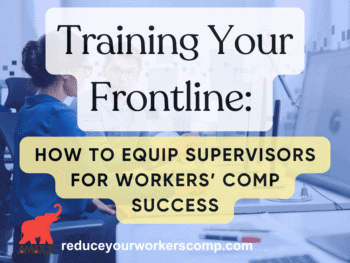
Platforms for Injury Triage
Advancements in technology have allowed injury triage programs to expand employers’ opportunities to implement an injury triage program. These models include:
- Smartphone applications: Everyone has a smartphone, which allows them access to apps built to perform injury triage functions. This includes taking pictures of the accident scene, and completing forms. This can be done via online chat features or telephone. These apps also promote the accuracy at which information is input into a claim system and ensure data integrity; or
Click Link to Access Free PDF Download
“13 Research Studies to Prove Value of Return-to-Work Program & Gain Stakeholder Buy-In”
- Telephonic injury triage: This involves more traditional lines of communication via telephone. Following a work injury, the employee or supervisor can contact an offsite triage nurse to assess a work injury. This same nurse can also direct medical care when necessary, and assist with other required follow-ups.
When in doubt, call 911 following a work injury where the employee’s life is in jeopardy. The goal of injury triage is to ensure the employee receives proper immediate medical care and treatment and ensure the incident is properly reported.
Deeper Dive: The Roles of Injury Triage
The concept of “triage” is not new to healthcare. It was first developed in wartime situations to allow medical staff to evaluate the needs of a soldier and best direct and prioritize medical care. In the context of workers’ compensation, injury triage has the same effect.
- Mechanism of Injury: It is important to capture information regarding the mechanism of injury. This is because a claimed injury sometimes may not fit the motions and activities occurring at that moment. This can include the frequency or time period at which a certain activity is performed. It can also include the movements such as lifting (how high an object is being lifted), or twisting, and bending. Failure to correctly capture this information can result in claims being unnecessarily accepted;
- Assessment of Post-Injury Condition: Hopefully, most injuries can be treated with an onsite first aid kit. This can include cleaning out an abrasion, and the use of gauze or bandages are common post-injury care. Other conditions require more specific guidance. This can include the assessment of one’s condition that involves sprains, strains, and fractures. Injury triage can identify problems and make recommendations such as whether to call an ambulance or transport an employee to a health care facility; and
- Health care Provider Referrals: Employers can and should establish a network of healthcare facilities where injured employees can receive medical care following an incident. This includes locations near the employer’s place of employment and within a greater community to provide easier access. Other affiliated locations can be included in a network to ensure traveling employees and those working in the field have immediate access to quality medical care. There is no downside to these networks. Most jurisdictions require multiple visits at the same facility in order for that provider to be considered the “primary” facility. This allows employees to receive medical care without fear of litigation to obtain a change in medical provider.
Injury triage can provide these services, which ensure proper injury reporting, and immediate medical care.
FREE DOWNLOAD: “13 Research Studies to Prove Value of Return-to-Work Program & Gain Stakeholder Buy-In”
Delivering Empathy When It is Needed
Nurse triage services also deliver the one benefit that means the most and costs nothing – empathy. It goes without saying that the workers’ compensation process can be frustrating from the employee’s point of view. They are facing a loss in wages and time spent receiving medical care. While using injury triage services does not right any perceived wrongs, it can provide empathy and direction. This benefit can pay dividends in the long run.
Conclusions
Interested stakeholders in the workers’ compensation system have an opportunity to reduce program costs via post-injury triage functions. It will provide for a best in class injury response and ensure the information related to a claim is being captured accurately. Implementing a program can also drive empathy and compassion, which means a lot to the injured employee. By taking steps to introduce this system into a program, overall costs can be reduced, which allows for additional claims to be resolved in a timely manner.

Contact: mstack@reduceyourworkerscomp.com.
Workers’ Comp Roundup Blog: https://blog.reduceyourworkerscomp.com/
©2021 Amaxx LLC. All rights reserved under International Copyright Law.
Do not use this information without independent verification. All state laws vary. You should consult with your insurance broker, attorney, or qualified professional.

















